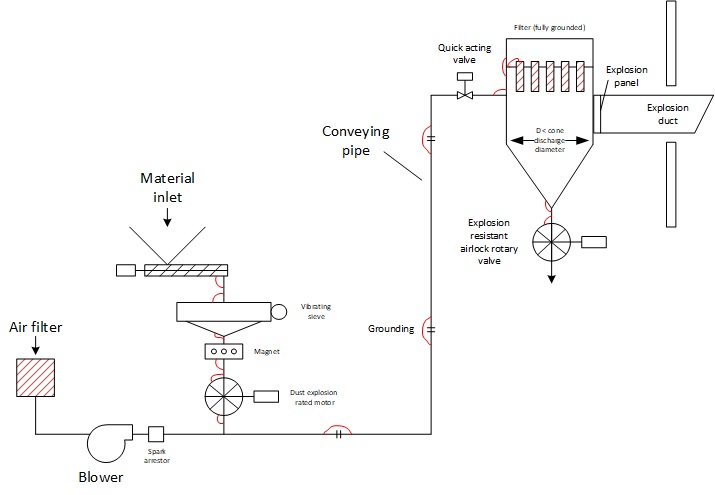
Pneumatic conveying : Dust explosion risks management
Good practices to ensure the safety of pneumatic transport systems against dust explosions
Do you have a question, a remark ? Please contact the author at admin@powderprocess.net
| Section summary |
|---|
| 1. Introduction |
| 2. Prevention |
| 3. Explosion vent for cone discharge
risks |
| 4. Inerting |
Go through this page to understand what can be the root causes of dust explosions in a powder or bulk solids pneumatic conveying system, and how to prevent and mitigate it.
1. Introduction
Pneumatic
conveying systems are generally safe systems compared to
other ways of conveying bulk solids. It remains however a system
conveying very often fine solids that can explode, it must
therefore be the object of a certain number of explosion
prevention measures, and in some cases of explosion mitigation.

Figure 1 : example of dust explosion
prevention and mitigation measures in a pneumatic conveying system
(note : which measure is to be implemented depends on the case
studied and must be confirmed by a dust
explosion analysis)
2. Prevention
Pneumatic conveying systems are quite favorable to explosion prevention. It is a closed system, without moving parts in the flow of product after introduction of the material in the pipe. However, the following measures must be implemented to ensure its safety :
- The system must be well maintained to avoid any leakage of product that could create an ATEX zone outside of the conveying pipe
- Even if it is quite difficult to carry a metallic foreign body of a sufficient size to create strong impact energy on the pipe, the pneumatic conveying line should be protected by equipment screening foreign bodies prior to conveying (sieves, magnet, metal detector...)
- The whole conveying line must
be grounded, included the filter in the receiver, to avoid any
electrostatics spark from an isolated conductive part (a
correct grounding can be verified by ensuring that the resistance
form a part to the earth is less than 10 ohms)
- If flexibles are used, they should be designed and installed in
a such a way that they cannot trigger propagating brush
discharges. Especially, if the flexible is reinforced by a
metallic wire, as it is often the case to give more mechanical
strength, the wire must be grounded at both ends (always
select a flexible having a wire with 2 grounding connections). The
static electricity that is created on the inner part of the
flexible will indeed migrate to the wire and must then be
evacuated. If the grounding is not present, the electricity will
accumulate until its potential is sufficient to discharge
suddenly, forming
a spark that is hazardous in ATEX environment.
Pneumatic conveying is indeed creating a lot of static electricity because of the movement of the product in the pipe, it is important to consider these different potential ignition sources in the risk analysis.
3. Explosion vent for cone discharge risks
As mentioned, the movement of the product in the conveying pipe is creating static electricity charges at the surface of the equipment, but also on the product itself. After transport, if the material is not conductive enough, those charges may build up and suddenly flow from the product to the hopper wall, triggering a cone discharge spark which can be enough to ignite the cloud of product in the free space of the hopper.
It is possible to calculate the size of the hopper on which a risk will be present. If the silo has a diameter bigger than the calculated value, the risk exist.
In design phase, it is then recommended to reduce the diameter of the silo. In case the size is still close to the calculated limit diameter, then it is advised to protect the hopper or silo against explosion.
Such protection has generally the following equipment :
- Explosion vent on the receiving hopper, properly sized
- Quick acting valve on the feed pipe, if there is a risk of propagation to other equipment
- If necessary, Ventex valve on clean air pipe and airlock rotary valve flame proof at the hopper outlet.
Note that, when handling a material having a low MIE, it can be necessary to protect the silo or hopper against explosion even if the cone discharge diameter is not exceeded. It is to take into account possible issues that may happen during the life of the installation, such as a grounding not put back in place correctly and leading to spark discharges.
4. Inerting
Another possibility to manage the risk of explosion is the prevent it through inerting. The oxygene level is kept below the low explosivity limit so that, in case of malfunction leading to a source of ignition, the explosion cannot happen due to a lack of oxygen, the comburant.
Such strategy requires a closed loop for the gas in the installation, in order to be able to keep the level of oxygen low while reducing the consumption of nitrogen. The system must be equipped with analysers to control the system by injecting nitrogen when necessary, or, even more importantly, shutting down the system the oxygen levels are too high. The system must also have a way to release an excess of gas if necessary through a balance line to keep the pressure in the system under control.
A pneumatic conveying system must be the object of a dust explosion risk analysis to identify the sources of ignitions and define the right prevention and mitigation measures. Conclusions of the risks analysis must be implemented by the factory.